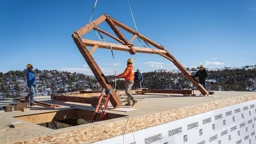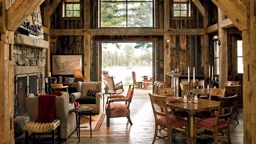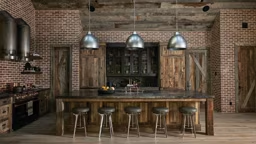There are many reasons people build timber homes, but one reason they all have in common is the love of wood as a building material thanks to its warmth, solidity and character. If they’re using reclaimed wood, double the character and add history to that list. With an increased consciousness about recycling and the environment, and an uptick in interest in handmade and American-made products, the demand for reclaimed lumber has doubled in the past decade, says Jennifer Young, general manager of Pioneer Millworks, with locations in Farmington, New York, and Portland, Oregon.
Where Does it Come From?
Reclaimed wood suitable for building can come from anywhere — factories, agricultural buildings, horse fencing, old barns, pickle vats, gym floors, bowling alleys and bleachers, just to name a few. It also can range in texture from rough-hewn — with gouges, nicks and insect trails intact — to smooth with clarity and no knots or nail holes. The majority of Pioneer Millwork’s wood for timber frames “comes from large industrial buildings,” says Michele Caryl, the company’s reclaimed wood acquisitions manager, who travels the nation sourcing wood. “We can get leaner, longer boards from buildings built in the 1900s and cut them down to create smaller timber profiles,” she says.Their surfaces are usually smooth-planed or rough-sawn. Agricultural wood from barns, for example, is usually hand hewn with an adz and has a lot of variation in dimension. “These timbers are more difficult to work with, but are more popular because of their rustic quality,” Caryl says. “An architect will sometimes ask for a particular size for a design, but we encourage them to design for the size the timber comes in.” Robby Williams, co-owner with his wife Pam Zentmyer, of Distinguished Boards + Beams in Carbondale, Colorado, sources his wood from old barns and commercial factories as well as overseas and in Canada.
If it’s a small enough source, his company will do the demolition. Larger commercial buildings he leaves to professional demolition companies. “We figure out the best way to take down the building in a safe manner making sure the wood isn’t damaged in any way,” he says. “Barns are built in bents, sections of building that hold the structure together. We dismantle it slowly, bent by bent. We salvage the flooring, too.” Small things are removed from the wood as they’re found on site, but when the wood gets to the yard, DB+B has a crew of people who clean and de-nail the wood in preparation for sale.
Strength & Durability
Because of reclaimed wood’s stability, it makes sense that many timber frames are being built with it, whether in the framing and support timbers or as accents on the interiors. “Timber framers have a lot of choices when picking framing wood,” Young says. “Reclaimed wood is incredibly stable because it was cut maybe 100 to 150 years ago — and from trees that were in some cases 400 years old.” The same strength can be achieved in a kiln as moisture is released from the wood, “but it’s best when it happens over time,” she says.Although old wood is already incredibly dry, it is kiln heated for two to seven days depending on its moisture content. This also kills any insects that might be in it. From there, the wood goes through various cutting machines to be smoothed out or left with its natural patina, depending on what a customer wants. With such dry and stable wood, the joinery will look the same way in 10 years. “It yields the nicest finish joinery we can achieve when cutting timber,” says Eric Fraser, timber frame manager at timber frame homebuilder New Energy Works Timberframers, sister company to Pioneer Millworks in Farmington, New York.
A Lesson in History
At Pioneer Millworks, 1.5 million board feet will be purchased this year. The wood is inventoried and tagged with a digital bar code. “Customers like to know the history of the wood and where their wood came from,” Young says. And they want something unique. “Maybe it still has the original circular saw marks, or customers want the grey patina on the barn siding to be used for paneling. Bleacher boards might have graffiti or aisle numbers stamped on them.” That history is part of what customers are willing to pay for, but the amount of overage also increases costs.“We have an expectation that 40 percent of the material won’t be usable — rotten or checked or just won’t turn into a good product,” Young says. When building a home with reclaimed wood, “You have to find twice as much as you need to make your product,” she says. There’s no fear that the industry will ever run out of product, though. “Ten years ago we didn’t have fence boards,” Caryl says. “It may not be antique but it’s salvageable. We recently came into a lot of wood from a maraschino cherry factory. We’re always finding new sources.” Regardless of where it’s found, it’s important to purchase reclaimed lumber from a reputable source that has a Forest Stewardship Council or Rainforest Alliance certification.
The Big Finish
While the term “reclaimed wood” invokes an image of something rustic and textured, plenty of people choose a smoother profile and use the wood in a variety of ways. “Our mainstay is flooring, but we sell a lot of vertical posts, collar ties, mantles — things used for more decorative purposes,” says Alice DeGennaro, co-owner of Longleaf Lumber, Inc., in Cambridge, Massachusetts, which gets its wood from 19th-century industrial buildings and barns in the Northeast. For flooring, DeGennaro says, consider color, tone and use. “If someone says, ‘I have three kids and two dogs,’ I know they need something durable to hold up to heavy traffic,” DeGennaro says.She suggests a hard wood like oak, maple or hickory. “We have a skipped oak with the original patina with lots of saw marks and variations in tone. That really hides wear and tear well.” If they want a farmhouse look — traditional super wide planks — they need to know that the wider the plank, the more gapping that might occur over time. There are so many stains and finish options that while the lumberyard may offer pre-finished choices, stain or other finish is most often left to the designer and homeowner to determine once the product is installed.












